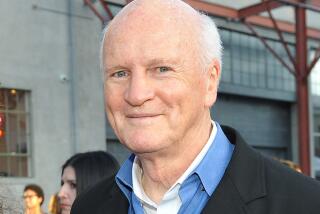Symbols of S&L; Excess Attract Eager Bidders
- Share via
MIAMI — More than 1,000 people jammed the white-marble “sky lobby” of the CenTrust Bank here Saturday, many to bid hungrily for a silver-plated piece of the wreckage from the collapse of the U.S. savings and loan industry.
About 16,000 pieces of Limoges china, Baccarat crystal, first edition books and even the Tiffany ashtrays in which deposed CenTrust Chairman David L. Paul ground out his gold-tipped cigarettes were snapped up in seven hours of spirited buying.
Paul, 50, became a national symbol of excess after the federal government in February seized control of the $8.2-billion thrift, the largest in the Southeast, saying the chairman’s lavish life style was being financed with depositors’ money. Paul remains under investigation by federal regulators.
Protecting CenTrust customers from his mismanagement could cost taxpayers more than $2 billion, according to L. William Seidman, chairman of the Federal Deposit Insurance Corp.
But many of those gathered in the bank’s majestic 11th floor lobby seemed to think of the auction as Paul’s unwitting success at trickle-down economics.
The contents of the bank’s executive dining room and Paul’s office were arrayed before the bidders in gleaming testament to what Seidman called the results of letting “somebody have a credit card on the United States of America, without any limit on it.”
Crystal flower vases went for $900 each. A pair of St. Hilaire fish dishes sold for $300 apiece. A Christofle cheese and pastry cart was knocked down for $3,500. Even ashtrays with CenTrust logos brought $175 each.
While paying himself $16 million in salary over the six years of his reign, the flamboyant Paul lived in a luxurious waterfront mansion, cruised in a $7-million yacht and once flew in six French chefs to prepare a dinner of truffle soup and pasta with caviar for guests to whom he wanted to show his latest acquisition, a painting by Flemish master Peter Paul Rubens.
In all, Paul owned $30-million worth of Old Master paintings, which were sold last year at a loss by the government.
The single most expensive item auctioned Saturday was a large painting called “Paul’s Pride,” an oil on canvas by Baltimore artist Douglas Hofmann that had hung in Paul’s office. The work depicts a lithographer named Paul and has nothing to do with the former CenTrust chief. Retired Chicago businessman Gilbert Kitt bought it for $25,000.
“I’m extremely happy to get this painting. Twenty-five thousand is a sensational price,” said Kitt, a collector who now lives in North Miami. “David Paul paid $65,000 for it.”
Also happy was auctioneer Jim Gall, who said that Kitt paid $10,000 more than the painting’s reserve price--the minimum at which it would be sold. But, Gall added, almost everything sold for much more than either auctioneers or the federal government anticipated. The total take, he said, topped $300,000.
“Double the turnout, double the prices. No, the prices are going through the roof,” crowed Gall, the proprietor of Miami-based Auction Co. of America. “We expected to sell that Baccarat crystal for $25,000. But we got more than $60,000.”
Also on the block were first editions of works by Ernest Hemingway, F. Scott Fitzgerald, George Orwell and many others, all of which had been rebound in leather. And most sold for well over the reserve price.
“It’s unreal,” said Edie Eisenstein, a Miami Beach bookseller who stood shaking her head as the numbers rose toward the ceiling two stories above. A copy of Hemingway’s “For Whom the Bell Tolls” went for $500, for example. A 28-volume signed set of works by H. G. Wells brought $2,900, more than $2,500 over the reserve.
“I don’t know who these people are but they don’t seem to know that first editions rebound in leather are worth less than in original covers,” Eisenstein said. “I’m passing out business cards like crazy.”
Gall said registered buyers came from dozens of states and several foreign countries. “Half are memorabilia seekers, some are dealers and some are just curious,” he said.
Andrea M. Plater of the Resolution Trust Co., which now runs CenTrust and some 260 other S&Ls; in conservatorship, said she had never seen anything like the opulence on display at CenTrust.
“It all symbolizes excess to me,” she said. “But it’s good for the taxpayers now, because (the proceeds) all go to offset the cost of dissolving the bank.”
More to Read
Inside the business of entertainment
The Wide Shot brings you news, analysis and insights on everything from streaming wars to production — and what it all means for the future.
You may occasionally receive promotional content from the Los Angeles Times.










